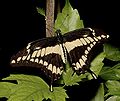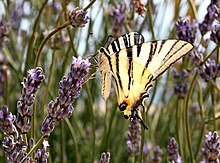
Hi Everybody!!
Good News to report: All over South Texas, it is a Banner Year for fruit trees! Everyone who grows fruit trees are as excited as I am to see the trees bursting with beautiful blossoms. A big thank you to the "weathermen" for bringing the cold chill down south. You see fruit trees in the south need a certain number of "chill hours" to set fruit. Personally, I have never seen such full fruit trees ever as winters are not typically as cold as this past season. Below is info from Wikipedia to explain the "chill hour requirement". Also, sharing a Black Beauty surprise: The first Swallowtail Butterfly of 2014. For those of You now considering planting fruit trees, you must check for what is best for your area. If you can grow a Red Baron Peach tree, I highly recommend it. Enjoy!

http://en.wikipedia.org/wiki/Chilling_requirement
Chilling requirement
From Wikipedia, the free encyclopedia
The chilling requirement of a fruit is the minimum period of cold weather after which a fruit-bearing tree will blossom. It is often expressed in chill hours, which can be calculated in different ways, all of which essentially involve adding up the total amount of time in a winter spent at certain temperatures.[1][2]
Some bulbs have chilling requirements to bloom, and some seeds have chilling requirements to sprout.
Biologically, the chilling requirement is a way of ensuring that vernalization occurs.
Chilling units or chilling hours[edit]
Chilling unit in agriculture is a metric of a plant's exposure to chilling temperatures. Chilling temperatures extend from freezing point to, depending on the model, 45 °F (7 °C) or even 60 °F (16 °C).[3] Stone fruit trees and certain other plants of temperate climate develop next year's buds in the summer. In the autumn the buds go dormant, and the switch to proper, healthy dormancy is triggered by a certain minimum exposure to chilling temperatures. Lack of such exposure results in delayed and substandard foliation, flowering and fruiting. One chilling unit, in the simplest models, is equal to one hour's exposure to the chilling temperature; these units are summed up for a whole season. Advanced models assign different weights to different temperature bands.
Chilling requirements[edit]
According to Fishman, chilling in trees acts in two stages. The first is reversible: chilling helps to build up the precursor to dormancy, but the process can be easily reversed with a rise in temperature. After the level of precursor reaches a certain threshold, dormancy becomes irreversible and will not be affected by short-term warm temperature peaks.[4] Apples have the highest chilling requirements of all fruit trees, followed by apricots and, lastly, peaches. Apple cultivars have a diverse range of permissible minimum chilling: most have been bred for temperate weather, but Gala and Fuji can be successfully grown in subtropicBakersfield, California.[5]
Peach cultivars in Texas range in their requirements from 100 chilling units (FlordaGrande cultivar, zoned for low chill regions) to 1,000 units (Surecrop, zoned for high chill regions).[6] Planting a low-chilling cultivar in a high-chill region risks loss of a year's harvest when an early bloom is hit by a spring frost.[6] A high-chilling cultivar planted in a low-chill region will, quite likely, never fruit at all. A four-year study of Ruston Red Alabama peach, which has a threshold of 850 chilling units, demonstrated that a seasonal chilling deficiency of less than 50 units has no effect on harvest. Deficiency of 50 to 100 units may result in loss of up to 50% of expected harvest. Deficiency of 250 hours and more is a sure loss of practically whole harvest; the few fruit will be of very poor quality and have no market value.[7] Rest-breaking agents (e.g. hydrogen cyanamide, trade name BudPro or Dormex), applied in spring, can partially mitigate the effects of insufficient chilling. BudPro can substitute for up to 300 hours of chilling, but an excessive spraying and timing error can easily damage the buds.[7] Other products such as Dormex use stabilizing compounds.
Chilling of orange trees has two effects. First, it increases production of carotenoids and decreases chlorophyll content of the fruit, improving their appearance and, ultimately, their market value. Second, the "quasi-dormancy" experienced by orange trees triggers concentrated flowering in spring, as opposed to more or less uniform round-the-year flowering and fruiting in warmer climates.[5]
Biennial plants like cabbage, sugar beet, celery and carrots need chilling to develop second-year flowering buds. Excessive chilling in the early stages of a sugar beet seedling, on the contrary, may trigger undesired growth of a flowering stem (bolting) in its first year. This phenomenon has been offset by breeding sugar beet cultivars with a higher minimum chilling threshold. Such cultivars can be seeded earlier than normal without the risk of bolting.[5]
Models[edit]
All models require hourly recording of temperatures.[4] The simplest model assigns one chilling unit for every full hour at temperatures below 45 °F (7 °C). A slightly more sophisticated model excludes freezing temperatures, which do not contribute to proper dormancy cycle, and counts only hours with temperatures between 32 °F (0 °C) and 45 °F (7 °C).[3]
The Utah model assigns different weight to different temperature bands; a full unit per hour is assigned only to temperatures between 37 °F (3 °C) and 48 °F (9 °C). Maximum effect is achieved at 7 °C (45 °F).[4] Temperatures between 55 °F (13 °C) and 60 °F (16 °C) (the threshold between chilling and warm weather) have zero weight, and higher temperature have negative weights: they reduce the beneficial effects of an already accumulated chilling hours.[3]
Southwick et al. wrote that neither of these models is accurate enough to account for application of rest-breaking agents widely used in modern farming. They advocated the use of a dynamic model tailored to the two-stage explanation of dormancy.[4]


From the Google Search Index:
Red Baron Peach Tree Care | TastyLandscapeTastyLandscape
tastylandscape.com/2013/04/24/red-baron-peach/
Red Baron Peach | Dave Wilson Nursery
www.davewilson.com/...information/.../red-baron-...
Dave Wilson Nursery





The Spicebush Swallowtail Butterfly
(1st of 2014)


http://en.wikipedia.org/wiki/Swallowtail_butterfly
Swallowtail butterfly
From Wikipedia, the free encyclopedia
Swallowtail butterflies are large, colorful butterflies in the family Papilionidae, and include over 550 species.[1] Though the majority are tropical, members of the family inhabit every continent except Antarctica. The family includes the largest butterflies in the world, the birdwing butterflies of the genus Ornithoptera.[2]
Swallowtails have a number of distinctive features; for example, the Papilionid caterpillarbears a repugnatorial organ called the osmeterium on its prothorax. The osmeterium normally remains hidden, but when threatened, the larva turns it outward through a transverse dorsal groove[3] by inflating it with blood.
The forked appearance of the swallowtails' hind wings, which can be seen when the butterfly is resting with its wings spread, gave rise to the common name swallowtail. As for its formal name, Linnaeus chose Papilio for the type genus, as Papilio is Latin for 'butterfly'. For the specific epithets of the genus, Linnaeus applied the names of Greek heroes to the swallowtails. The type species: Papilio machaon honoured Machaon, one of the sons of Asclepius, mentioned in the Iliad.[4]
| Swallowtail Butterfly | |
|---|---|
 | |
| Scientific classification | |
| Kingdom: | Animalia |
| Phylum: | Arthropoda |
| Class: | Insecta |
| Order: | Lepidoptera |
| Suborder: | Ditrysia |
| Superfamily: | Papilionoidea |
| Family: | Papilionidae Latreille, [1802] |
| Type species | |
| Papilio machaon (Old World Swallowtail) | |
| Subfamilies and genera | |
There are 31 genera and about 600 species:
| |
Distribution[edit]
As of 2005, 552 extant species have been identified,[1] which are distributed across the tropical and temperate regions of all continents except Antarctica. Various species inhabit altitudes ranging from sea level to high mountains, as in the case of most species of Parnassius. The majority of swallowtail species and the greatest diversity in form and lifestyle are found in the tropics and subtropical regions between 20°N and 20°S,[5]:particularly Southeast Asia, and between 20°N and 40°N in East Asia. Only 12 species are found in Europe[6] and only one species, Papilio machaon is found in the British Isles.[6] North America has 40 species, including several tropical species andParnassius.[7]
The northernmost swallowtail is the Arctic Apollo (Parnassius arcticus), found in the Arctic Circle in northeastern Yakutia, at altitudes of 1500 meters above sea level.[8] In theHimalayas, various Apollo species such as Parnassius epaphus, have been found at altitudes of 6,000 meters above sea level.[9]:221
Appearance/Morphology[edit]
The detailed descriptions of morphological characteristics of the Papilionidae, as quoted in Bingham (1905) are as follows:[10]:1,2
Egg. "Dome-shaped, smooth or obscurely facetted, not as high as wide, somewhat leathery, opaque." (Doherty.)Larva. Stout, smooth or with a series of fleshy tubercles on the dorsum : sometimes with a raised fleshy protuberance (the so-called hood or crest) on the fourth segment. The second segment has a transverse opening, out of which the larva protrudes at will and an erect, forked, glandular fleshy organ that emits a strong, penetrating, and somewhat pleasant odor.Pupa. Variable in form but most often curved backwards. It is angulate, with the head truncate or rounded and the back of abdomen is smooth or tuberculate. It is attached by the tail, normally in a perpendicular position, and further secured by a silken girth round the middle. In Parnassius, the pupa is placed in a loose silken web between leaves.Imago. Wings extraordinarily variable in shape. Hind wing very frequently has a tail, which may be slender, or broad and spatulate, but is always an extension of the termen at vein 4. In one genus, Armandia, the termen of the hind wing is prolonged into tails at the apices of veins 2 and 3 as well as at vein 4. Pore wing (except in the aberrant genera Parnassius and Hypermnestra) with all 12 veins present and in addition a short internal vein, vein 1 a,[11] that invariably terminates on the dorsal margin.
Stages of development of a papilionid – Giant Swallowtail (Papilio cresphontes)
Papilioninae[edit]
The tribes recognised in the Papilioninae are Leptocircini, Teinopalpini, Troidini, and Papilionini.
Subfamily : Papilioninae.
Mating and Young[edit]
After mating, the male Parnassines produce a glue like substance that is used to seal the female genital opening and prevent other males from mating.[23] They lay individual eggs on the underside of the leaves of their food plants.[24] There is no parental investment once the eggs have been laid.
The pupae are typically attached to the substrate by the cremaster but with head up held by a silk girdle. The Apollos, however, pupate in debris on the ground and also build a loose cocoon. In the temperate regions, the winters are passed in a pupal diapausestage.
Food[edit]
The caterpillars of various swallowtail butterfly species feed on a wide range of different plants, most depending on only one of five families: Aristolochiaceae, Annonaceae,Lauraceae, Umbelliferae (Apiaceae) and Rutaceae. By eating some of these toxic plants, the caterpillars sequester aristolochic acid which renders both the caterpillars and the butterflies of some of these as toxic, thus protecting them from predators.[25]Swallowtail tribes Zerynthiini (Parnassiinae), Luehdorfiini (Parnassiinae) and Troidini (Papilioninae) almost exclusively use the Aristolochiaceae family as their host plants.
For example, the Eastern Black Swallowtail's main main host plant in the wild is Queen Anne's Lace, but they also eat garden plants in the carrot family, including carrots, parsley, dill, and fennel.[13]
Adult swallowtails sip nectar, but also mud and sometimes manure.[24]

...this is brendasue signing off from Rainbow Creek. See
You next time!














No comments:
Post a Comment
Hi Everybody! Please say hello and follow so I know you are here! Due to the inconsideration of people trying to put commercials on my blog comment area, I have restricted use of anonymous posts. Sorry that some hurt all.
My public email is katescabin@gmail.com No spammers or trolls